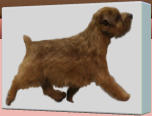

Breeders Corner

Kafka said, "All knowledge, the
totality of all questions and
answers, is contained in the dog."

Please submit your article,
publication or hyperlink to an
article to Judi Hartell.
DataDawg@Austin.rr.com
Submissions

Quote



The Bluebonnet Norfolk Terrier Club does not recommend,
guarantee, endorse, nor rate these recommendations or
contributors, their kennel or their stock. The purpose of this section
is to share the knowledge and experience of breeders who have vast
experience in whelping and raising puppies. The tips and tricks
below are intended to augment qualified veterinarian care, not as a
substitute for qualified veterinarian care of the dam and puppies.






Inbreeding: Inbreeding is defined as the mating of animals "more closely related to
one another than the average relationship within the breed." Inbred pairings would
include brother/sister (the closest form), father/daughter, mother/son and half-
brother/half-sister.
Linebreeding and Inbreeding involve the mating of animals within the same family.
Breeding relatives is used to cement traits, the goal being to make the offspring
homozygous (pure) for desirable characteristics. Homozygous dogs tend to be
prepotent and produce offspring that look like themselves (Walkowica & Wilcox 1994)
Linebreeding is frequently misunderstood and miscommunicated; in fact, it is not
altogether uncommon for an outcrossed pedigree to be mistakenly viewed as
linebreeding by the novice. We can more clearly define linebreeding and how we can
more accurately describe our linebred litters.
The effects of linebreeding: Good shoulder and stifle angulation and good
temperament are considered Recissive traits by most authorities. She temperaments
and poor angulation are theoretically considered dominant traits. Breeders need to
understand Dominant and Recessive genes in order to promote the positive traits and
decrease the negative traits in our breeds.
Dominant & Recessive Genes. There are two types of genes whose interaction help
determine which trait will be passed on to a new-born puppy:
Dominant genes "win out" over recessive genes
Use capital letters for dominant genes (ex T for ticking)
Use lower case letters for recessive genes (ex t for non-ticking)
Example, a dog inheriting T from the sire and t from the dam will have the gene par Tt
and will have ticking.


- Behavior
- Honor Roll
- Living With Norfolk Terriers
- Fun With Your Norfolk
- Tip Of The Week
- Publications
- Therapy and Service Dogs
- Health & Nutrition
- Competition


- Books
- Clubs
- Collectibles, Gifts & Fun Activities
- Companion Animal Recovery
- Dog Show Superintendents
- Genetics
- Health Related Sites
- Canine Health Links
- Vaccination Protocols
- Animal Health Trust
- Online Mendelian Inheritance In Animals
- Univ. Of Cambridge Vet. School
- Canine Inherited Disorders Database
- All Creatures Veterinary Hospital
- A First Aid Kit
- Veterinary Pet Insurance
- AKC Pet Health Plan
- Cornell Univ. College of Vet. Medicine
- More Health Related Sites
- Independent Sites
- Pet Travel
- Training Your Puppy
- Publications


- Breeding Tips
- Breeding Tips Page One
- Breeding Tips Page Two
- Breeding Tips Page Three
- Breeding Tips Page Four
- Breeding Tips Page Five
- Breeding Tips Page Six
- Virus &The Pregnant Bitch
- Dog Neutering Video
- Vaccinations & The Pregnant Bitch
- Incontinence In The Pregnant Bitch
- Flagyl & The Pregnant Bitch
- Canine Reproduction
- Frozen vs Chilled Semen
- Modern Breeding Management
- Dialogue On Rasberry Leaves
- Monitoring Pregnancy
- Uses For Vaginal Cultures
- OFA & The Pregnant Bitch
- Breeding Tips Page Seven
- Breeding Tips Page Eight
- Breeding Tips Page Nine
- Breeding Tips Page Ten
- Breeding Tips Page Eleven
- Breeding Tips Page Twelve
- Breeding Tips Page Thirteen
- Breeding Tips Page Fourteen
- Genetics And Inheritance
- Rescue









